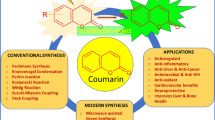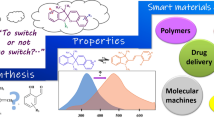Abstract
Benzanthrone derivatives are potential fluorescent probes for various chemical and biological environments. A mechanistic understanding of their photophysical properties is pivotal for designing an efficient fluorescence sensor based on the benzanthrone framework. In this study, we report on the effect of chemical substitution on the photophysical properties of two benzanthrone derivatives, namely, 3-(N′-methyl)-piperazino-7H-benzo[de]anthracen-7-one [Me-PBA] and 3-(N′-phenyl)-piperazino-7H-benzo[de]anthracen-7-one [Ph-PBA] in different solvents and solvent mixtures of varying polarities and proticities. Both benzanthrone derivatives show interesting solvent-dependent photophysical properties. Although both derivatives exhibit strong intramolecular charge transfer (ICT) characteristics in the excited state, the extent of the charge transfer is significantly influenced by the nature of the chemical substitution. Modulation of photophysical parameters as a function of solvent properties led us to propose that ICT is affected by solvent polarity and hydrogen bonding. From the viscosity effect, it is revealed that the weaker emission of Ph-PBA compared to Me-PBA in polar solvents is primarily due to the non-radiative torsional motion of the phenyl group in the former derivative. In protic solvents, intermolecular hydrogen bonding imparts strong non-radiative deactivation to both derivatives, thus rendering a weak fluorescence yield.
Similar content being viewed by others
References
B. M. Krasovitskii and B. M. Bolotin, Organic luminescent materials, Wiley-VCH Publishers, New York, 1988.
U. H. F. Bunz, Chem. Rev., 2000, 100, 1605.
G. Hughes and M. R. Bryce, J. Mater. Chem., 2005, 15, 94.
T. W. Kelley, P. F. Baude, C. Gerlach, D. Muyres, A. H. Michael, E. V. Dennis and D. T. Steven, Chem. Mater., 2004, 16, 4413.
Y. Shirota and H. Kageyama, Chem. Rev., 2007, 107, 953.
S. Logothetidis, Mater. Sci. Eng., B, 2008, 152, 96.
E. M. Kirilova, I. Meirovics and S. V. Belyakov, Chem. Heterocycl. Compd., 2002, 38, 789.
E. M. Kirilova, I. Kalnina, G. K. Kirilov and I. Meirovics, J. Fluoresc., 2008, 18, 645.
F. Carlini, C. Paffoni and G. Boffa, Dyes Pigm., 1982, 3, 59.
V. Bojinov and I. Grabchev, Org. Lett., 2003, 5, 2185.
I. Grabchev and I. Moneva, Dyes Pigm., 1998, 38, 155.
I. Grabchev, V. Bojinov and I. Moneva, J. Mol. Struct., 1998, 471, 19.
X. Yang, W. H. Liu, W. J. Jin, G. L. Shen and R. Q. Yu, Spectrochim. Acta, Part A, 1999, 55, 2719.
S. Dumas, I. Grabchev, P. Stoikova, J. Chauvin and J. M. Chovelon, J. Photochem. Photobiol., A, 2009, 201, 237.
D. Staneva, R. Betcheva and J. M. Chovelon, J. Photochem. Photobiol., A, 2006, 183, 159.
D. Staneva and R. Becheva, Dyes Pigm., 2007, 74, 148.
D. Staneva, R. Betcheva and J. M. Chovelon, J. Appl. Polym. Sci., 2007, 106, 1950.
D. Staneva, E. V. Tonkova, I. Mohamad Saleh, M. S. I. Makki, T. R. Sobahi, R. Mohamed Abdel-Rahman, M. A. Abdullah and I. Grabchev, J. Photochem. Photobiol., B, 2015, 143, 44.
O. Ryzhova, V. Kateryna, V. Trusova, E. Kirilova, G. Kirilov, G. Gorbenko and P. Kinnunen, Methods Appl. Fluoresc., 2016, 4, 034007.
K. Vus, V. Trusova, G. Gorbenko, E. Kirilova, G. Kirilov, I. Kalnina and P. Kinnunen, Chem. Phys. Lett., 2012, 532, 110.
O. Zhytniakivska, V. Trusova, G. Gorbenko, E. Kirilova, I. Kalnina, G. K. Kirilov and P. Kinnunen, J. Lumin., 2014, 146, 307.
T. Konstantinova, P. Peallier, H. Konstantinov and D. Staneva, Polym. Degrad. Stab., 1995, 48, 161.
I. Grabchev, I. Moneva, I. Kozlov and G. Elyashevich, Mater. Res., 2001, 4, 301.
I. Grabchev, I. Moneva, E. Wolarz, D. Bauman and S. Stouyanov, Z. Naturforsch., 2001, 56, 291.
I. Grabchev, I. Moneva, E. Wolarz and D. Bauman, Dyes Pigm., 2003, 58, 1.
P. Kapusta, O. Machalicky, R. Hrdina, M. Nepras, B. Matthew Zimmt and V. Fidler, J. Phys. Chem., 2003, 107, 9740.
J. R. Lakowicz, Principles of Fluorescence Spectroscopy, Springer, PlenumPress, New York, 1983.
B. Siddlingeshwar, S. M. Hanagodimath, E. M. Kirilova and G. K. Kirilov, J. Quant. Spectrosc. Radiat. Transfer, 2011, 112, 448.
D. Patra, N. N. Malaeb, J. M. Haddadin and J. M. Kurth, J. Fluoresc., 2012, 22, 707.
D. Patra and C. Barakat, Spectrochim. Acta, Part A, 2011, 79, 1034.
A. C. Testa, J. Lumin., 1991, 50, 243.
P. R. Bangal, S. Panja and S. Chakravorti, J. Photochem. Photobiol., A, 2001, 139, 5.
H. Ke-Li and Z. Guang-Jiu, Hydrogen Bonding and Transfer in the Excited State, John Wiley & Sons Ltd., UK, 2nd edn, 2011.
F. A. S. Chipem, A. Mishra and G. Krishnamoorthy, Phys. Chem. Chem. Phys., 2012, 14, 8775.
S. Senthilkumar, S. Nath and H. Pal, Photochem. Photobiol., 2004, 80, 104.
B. Manna, R. Ghosh and D. K. Palit, J. Phys. Chem. C, 2016, 120, 7299.
E. Z. Lippert, Naturforsch., 1955, 10, 541.
N. Mataga, Y. Kaifu and M. Koizumi, Bull. Chem. Soc. Jpn., 1956, 29, 465.
J. A. Dean, Lange's Handbook of Chemistry, McGraw-Hill, New York, 1987.
H. Masuhara, T. Hino and N. Mataga, J. Phys. Chem., 1975, 79, 994.
H. Masuhara and N. Mataga, Acc. Chem. Res., 1981, 14, 312.
C. F. Chapman, R. S. Fee and M. Maroncelli, J. Phys. Chem., 1995, 99, 4811.
E. Lippert, Phys. Chem., 1957, 61, 962.
N. Mataga, Bull. Chem. Soc. Jpn., 1963, 36, 654.
N. Mataga and T. Kubota, Molecular Interactions and Electronic Spectra, Dekker, New York, 1970.
J. T. Edward, J. Chem. Educ., 1970, 47, 262.
A. K. Satpati, M. Kumbhakar, D. K. Maity and H. Pal, Chem. Phys. Lett., 2005, 407, 114.
Z. R. Grabowski, K. Rotkiewicz and W. Rettig, Chem. Rev., 2003, 103, 3899.
P. K. Singh, M. Kumbhakar, H. Pal and S. Nath, J. Phys. Chem. B, 2010, 114, 5920.
R. A. Ghotli, A. R. A. Aziz, I. M. Atadashi, D. B. Hasan, P. S. Kong and M. K. Aroua, J. Ind. Eng. Chem., 2015, 21, 1039
http://www.aciscience.org/docs/physical_pro-perties_of_glycerine_and_its_solutions.pdf.
Acknowledgements
The authors are grateful to the deanship of Scientific Research, King Saud University for funding through Vice Deanship of Scientific Research Chairs. Authors BS and SN thank Dr. Sukhendu Nath and Dr. Rajib Ghosh of Radiation & Photochemistry Division of BARC, Mumbai for their continuous help in experiments and preparing the manuscript.
Author information
Authors and Affiliations
Corresponding author
Rights and permissions
About this article
Cite this article
Shivraj, Siddlingeshwar, B., Kirilova, E.M. et al. Photophysical properties of benzanthrone derivatives: effect of substituent, solvent polarity and hydrogen bonding. Photochem Photobiol Sci 17, 453–464 (2018). https://doi.org/10.1039/c7pp00392g
Received:
Accepted:
Published:
Issue Date:
DOI: https://doi.org/10.1039/c7pp00392g




